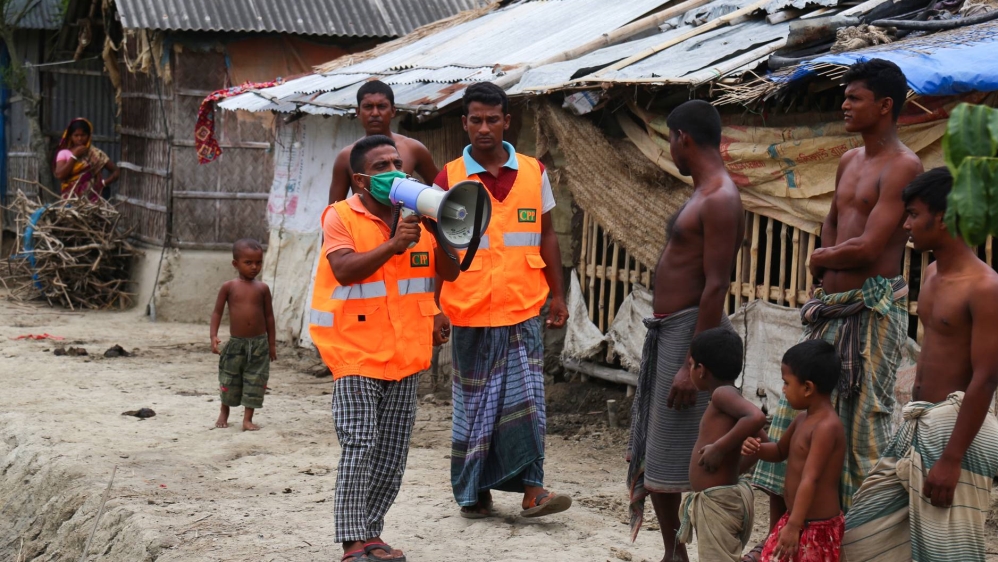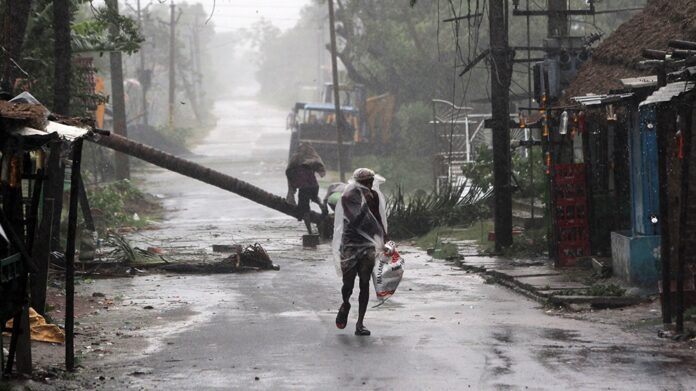Cyclone Amphan, one of the most powerful in decades, has begun to make landfall along the coastline of India and Bangladesh where more than 2.6 million people fled to shelters in a frantic evacuation made all the more challenging by the coronavirus pandemic.
“The cyclone has made landfall. The eye is over Sagar Island,” Sanjib Banerjee, director of the regional meteorological office in Kolkata, told the AFP news agency on Wednesday, referring to India’s east coast.
More:
Weather officials say the cyclone – packing winds of up to 190kph (120 miles an hour) – could wreak havoc in India and Bangladesh, and millions of coastal residents have evacuated or battened down ahead of the storm’s approach.
Authorities warned it could cause extensive damage to flimsy houses and a storm surge could push seawater 25km (15 miles) inland, flooding cities including Kolkata.
Coconut trees swayed wildly, electric poles lay scattered on the roads of Kolkata, rain pounded fishing villages, and rivers surged as the storm battered the coast.
Watch | Moment captured as #CycloneAmphan makes landfall in West Bengal’s Digha pic.twitter.com/xZczD8od6b
— NDTV (@ndtv) May 20, 2020
‘Next 24 hours crucial’
“The next 24 hours are very crucial. This is a long haul,” said M Mohapatra, India’s meteorological chief.
The region, with 58 million people in the two bordering countries, has some of the most vulnerable communities in South Asia: poor fishing communities in the Sunderbans and over a million Rohingya refugees living in crowded camps in Cox’s Bazar in Bangladesh.
Al Jazeera’s Tanvir Chowdhury, reporting from Bangladeshi capital Dhaka, said 1.4 million people have been evacuated and put into shelter but at least 46,000 people remained in the clear line of danger on some of the islands in the coastal areas.
“There is accommodation for at least five million people and there is medical team, rescue operation team, coastguard and the navy have been put on alert and standby in the coastal areas,” he said.
“This would be one of the biggest cyclones so they are taking it very seriously.”
The Indian weather department forecast a storm surge of 10 to 16-foot (3-4 metre) waves – as high as a two-storey house – that could swamp mud dwellings along the coast, uproot communication towers and inundate roads and railway tracks.
There will be extensive damage to standing crops and plantations in the states of West Bengal and Odisha, the weather service said in a bulletin late on Tuesday.
Authorities were hastily repurposing quarantine facilities for the looming cyclone soon after easing the world’s biggest lockdown against the coronavirus. India has reported more than 100,000 cases with 3,163 deaths.
About 300,000 people had been moved to storm shelters, West Bengal Chief Minister Mamata Banerjee said. The state capital Kolkata lies near the cyclone’s path and there was concern about people living in about 1,500 old, dilapidated buildings.
Kolkata was battered by heavy rain and the muddy Hooghly River was rising under dark skies, while in the coastal resort of Digha, large waves were pounding the shore.

A Cyclone Preparedness Programme (CPP) volunteer uses a megaphone to urge residents to evacuate to shelters ahead of the expected landfall of cyclone Amphan in Khulna, Bangladesh on Tuesday [Kazi Shanto/ AFP]
Rohingya refugees vulnerable
In neighbouring Bangladesh, officials said the cyclone could set off tidal waves and heavy rainfall, unleashing floods.
The cyclone is expected to hit the districts of Chittagong and Khulna, just 150 km (93 miles) from refugee camps housing more than a million Rohingya in flimsy shelters.
The UN said food, tarpaulins and water purification tablets had been stockpiled, while authorities said the refugees would be moved to sturdier buildings if needed.
“We are fully prepared. But right now, there is no need to take them to cyclone shelters,” said Mahbub Alam Talukder, Bangladesh’s refugee commissioner.
Authorities in Bangladesh have also moved hundreds of Rohingya refugees living on a flood-prone island in the Bay of Bengal to storm shelters as the super cyclone barrels down.
The eastern edge of the storm headed for Bangladesh and neighbouring India is expected to batter Bhasan Char island, where 306 Rohingya, members of a persecuted minority from Myanmar, were sent this month after being rescued from boats.
“Each block has a cyclone centre and they have been moved to the centre,” said Bimal Chakma, a senior official of the Refugee Relief and Repatriation Commission.
The United Nations has called for the refugees to be moved to the mainland to join more than a million more who live in sprawling camps outside the town of Cox’s Bazar.
Bangladesh’s low-lying coast, home to 30 million people, and India’s east are regularly battered by cyclones that have claimed the lives of hundreds of thousands of people in recent decades.
The eastern Indian state of Odisha was hit by a super cyclone that left nearly 10,000 dead in 1999, eight years after a typhoon, tornadoes and flooding killed 139,000 in Bangladesh. In 1970, Cyclone Bhola killed half a million people.






